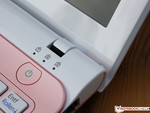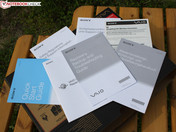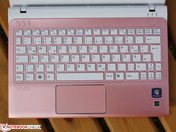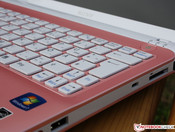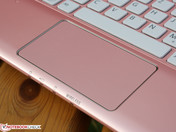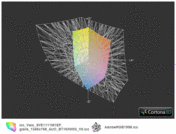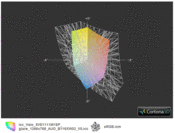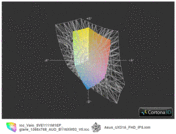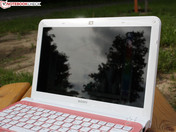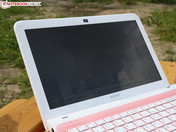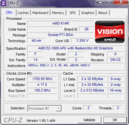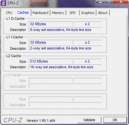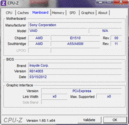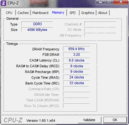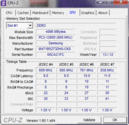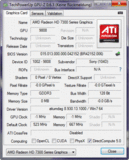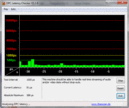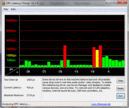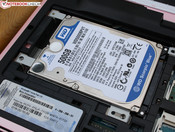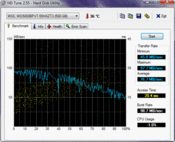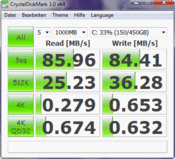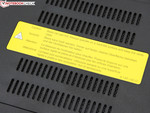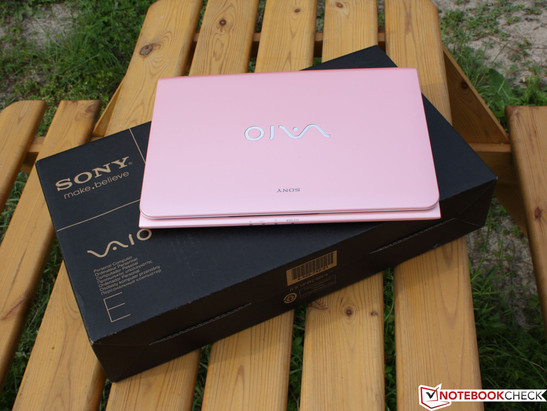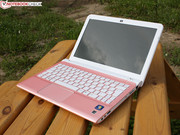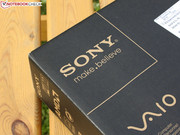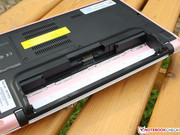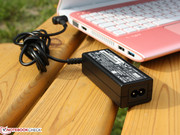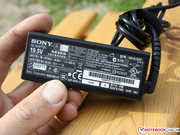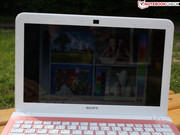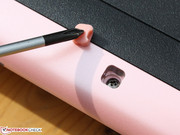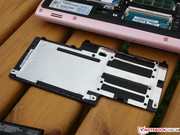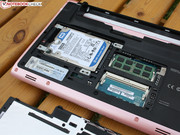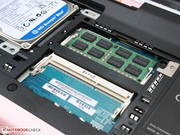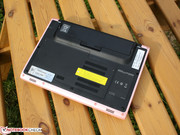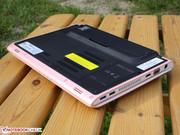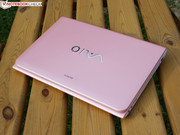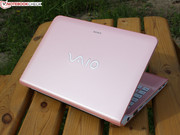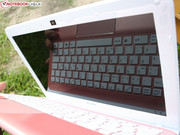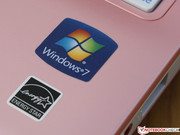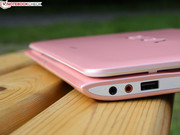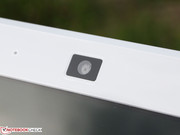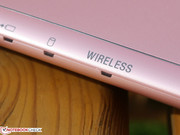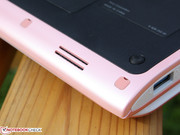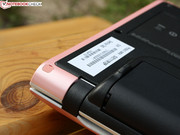Quick Review Sony Vaio SVE-1111M1E/P Subnotebook

It's not the first time that one of AMD's APUs is seen powering a Sony subnotebook. With few exceptions, however, Sony has so far only trusted AMD with their smallest consumer offerings, notably the E Series E-450 and E-350 (Brazos 1.0) in the Vaio VPC-YB1S1E/S and the VPC-YB3V1E/S (update), respectively.
The Vaio SVE series replaces the 11.6-inch YB models. The target market remains the same: price conscious consumers who value style more than performance. Sony has certainly hit the mark with its unusual and sleek design. Time for us to find out if the new 11.6-inch model improves on its Brazos 1.0 predecessor in terms of battery life, workmanship and display quality. We had previously been especially critical of the input devices and of the reflective screen.
On the technical side, we are chiefly interested in the AMD-APU E2-1800 (Brazos 2.0), which includes new integrated graphics in the Radeon HD 7430M. Will it improve the poor gaming performance of the previous generation APU (HD 6320)? Our expectations are not huge, but some casual gaming at low detail and resolution would be appreciated.
Case
The 11.6-inch model comes in a wrap-design case. Gone is the cylinder-look of the old Vaio, the lid and base unit are now stacked like folded papers. Even though the wrap concept requires a bit of imagination, it nevertheless makes for a nice exterior. The same cannot be said for the firmness of the base unit; with two hands, we managed to bend the chassis which responded with a squeaking sound.
The hinges are fitted to the chassis rather loosely without a well-defined limit, and let the lid rock back and forth considerably. The back of the display can only be depressed in the center with some force, and does not flex easily. The hinges allow for a maximum opening angle of about 140 degrees.
High gloss surfaces prone to attracting finger prints are limited to the white fancy looking areas. By contrast, the pink areas do a good job of hiding finger prints, and hit a sweet spot between a glossy and matte texture. The base plate features a large opening that gives access to two RAM slots and the 2.5-inch HDD.
Connectivity
With HDMI, USB 3.0 and VGA, the Vaio SVE covers all the basics, on par with competing offers in this segment of the market. The arrangement of the connectors is sensible: The VGA and HDMI ports are located at the very back on the left side, which allows the thick cables to be led out-of-the-way, without interfering with mouse movement.
Communication
Gigabit Ethernet and Draft-N Wireless are common features on today's laptops, and can also be found on board the Vaio. The Bluetooth 4.0+HS adaptor is new. The 1.3 MP webcam is capable of 5 MP still pictures (2,560 x 2,048).
Accessories
The "assist" button, placed left above the keyboard, calls up Vaio Care. Using the admin tool, users can install updates or create recovery media. This is recommended for new Vaio owners, since no physical recovery media are included in the box.
Warranty
Sony offers a 12 months manufacturer warranty.
Input Devices
Keyboard
The black keyboard seen on the Vaio YB and YA (11.6-inch) is replaced by a white keyboard with matte finish. The layout remains unchanged, except for a shrink of the arrow keys. This has allowed for a slightly larger right shift key, one of our criticisms in our test of the predecessor (Vaio YB1).
The keyboard feels firm only on the left hand side. On the right hand side, key strokes give rise to vibrations, and typing feels less accurate. The feedback is accurate, but key travel is so low that typing feels less than relaxing.
Touchpad
We are able to move the cursor across the screen accurately, but the smooth and relatively large surface feels a little unresponsive. The usual gestures of multi-touch pads (this one is a Synaptic ClickPad V8.1) such as zooming in and out or flicking pages work as expected. The mouse keys are located on the front left and right, underneath the surface. In addition, pressing the front or middle of the touchpad also causes a left click.
The surface itself is sensitive throughout, but this does not interfere with the mouse keys. The big drawbacks of the ClickPad are its tiny key travel and weakly defined tactile feedback. At the front, near the mouse keys, they already feel low, but the further we move up the touchpad, the shallower they become, until disappearing completely. The result is a clumsy and rather slow operation.
Display
The 11.6-inch screen is made by AUO (type B116XW03 V0) and features a resolution of 1.366 x 768 pixels. This high resolution has been the norm on 11.6-inch screens for several years, and measurements are pretty comparable. The surface is glossy, which makes for vibrant colors, but also means strong reflections under day light. Despite deceptive first appearances, the measured contrast of just 175:1 is weak.
The current model no longer relies on the low contrast CMO panel of the predecessor Vaio VPC-YB1S1E/S, but the contrast on the new panel remains equally poor. The luminance is decreased slightly.
The color space, which we compared to AdobeRGB, sRGB, and to the panel of the Asus UX31A FHD IPS (transparent), is very small, but for less than 1000 Euros (1230 USD) the competition is equally weak. However, color space is only relevant for professional image manipulation and CAD/CAM users, who will not be in the market for a low performance lifestyle subnotebook anyway.
| |||||||||||||||||||||||||
Brightness Distribution: 89 %
Center on Battery: 220 cd/m²
Contrast: 175:1 (Black: 1.26 cd/m²)
35.47% AdobeRGB 1998 (Argyll 3D)
44.31% sRGB (Argyll 3D)
33.67% Display P3 (Argyll 3D)
The darkroom picture reveals the narrow viewing angles of the Vaio SVE. They become an issue when more than one pair of eyes are looking at the screen together, not an unrealistic scenario for a lifestyle subnotebook. Horizontal viewing angles are still acceptable. Colors remain true up to 50 degrees away from the central perspective and start to invert only beyond this range. In the vertical, things get worse much quicker: text remains clearly legible only up to 35 degrees, while colors change at just 20 degrees.
Performance
Sony has equipped its 11.6-inch model with an AMD dual-core APU. This Accelerated Processing Unit combines a CPU with an integrated graphics chipset and a memory controller (single channel DDR3-1333). Compared with Intel processors that also include a GPU, the CPU's performance is quite weak. Thanks to its low power consumption, the APU is meant to make up for this with longer running times in netbooks and subnotebooks.
The AMD E2-1800 marks the end of the E-350 and E-450 era, which have been found in countless cheap notebooks, subnotebooks and netbooks since early 2011. The TDP remains at 18 Watts. The core clock rate moves up to 1.7 Ghz (from 1.65 Ghz in the E-450). Unlike in Intel CPUs, there's no turbo boost.
The integrated Radeon HD 7340 with DirectX-11 and a UVD3 video decoder for HD video playback (MPEG-2, H.264, VC-1) might be a bit faster than its predecessor, the HD 6320. We'll see below whether the Radeon outperforms Intel's integrated graphics.
The Vaio ships with 4,096 MB DDR3 RAM (1 x 4 GB). This can be easily upgraded to 8 GB, thanks to a second (empty) memory slot. Sony has configured the 64-bit Windows 7 Home Premium, which takes full advantage of the 64-bit APU.
Processor
We compare the computing performance of the E2-1800 with its predecessors, AMD E-450 (2 x 1.65 GHz) and E-350 (2 x 1.60 Ghz). In addition, we'd like to know just how much faster the current Intel Pentium and i5 low voltage CPUs are. The Cinebench R11.5 64-Bit single and multi core bench marks will be our tool for the job.
The E2-1800 reaches only 0.62 points in multi-core mode, on par with the E-450. The Celeron B810 and Pentium P6100 (low-cost) are 102% and 210% faster, respectively. The low voltage i3 2357M (2 x 1.3 Ghz) scores 103% higher, while the i5 3317U that is found in most ultrabooks, runs 284% faster on average. Since the Intel Atom CPUs are no longer relevant, this puts the system right at the bottom of the current PC market, apart from AMD C-50, E-300 models, etc.
The same story is repeated in the single-core test: 0.33 points, compared to 0.31 points for the E-450. The 3317U is 234% faster, a Pentium P6200 comes in at +120%. AMDs own Pumori platform for subnotebooks (A10-4600M) is 119% faster.
Because the Bobcat cores don't include a turbo boost feature (available only with Llano APUs), the clock speed under load is a constant 1.7 Ghz. The user can only lower the speed, by limiting the frequency in the Vision Control Center. The same CPU and GPU performance is available on battery; we repeatedly measured 86.3 BPS in the R11.5 shading test.
System Performance
The CPU tests revealed the AMD E2-1800 to be only marginally faster than its predecessors, the E-350 and E-450. What does that mean for an application bench mark? Here, the hard disk, the RAM and the GPU will also play a role.
The result is poor: the score of 965 points in PCMark 7 is lower than the Samsung 305U1A (1005 points) which includes the E-450. An explanation could be the lower PCMark 7 storage score (1341 vs 1456 points). Even the entertainment score (994 vs 1027) is lower in the Vaio.
E-450 notebooks such as the U32U-RX042V (13.3-inch) or the HP Compaq Presario CQ57 (15.6-inch) run at a more or less similar level. The only models that the Vaio manages to outperform are Atom based netbooks, but since they are no longer the only ones to offer decent battery life, these have all but disappeared from the market. The Acer Aspire One D270 (-31%) is squarely beaten by the Brazos 2. Compared to ultrabooks like the Acer Aspire V5-571G (+93%; CPU: 3317U), the Vaio is left in the dust.
Beyond the subnotebook range, our Vaio is considerably slower than even a basic office model with Intel's Core i3 2330M and integrated graphics (+75 to 80%). For example, the Asus Pro P53E scores 83% higher in the PCMark 7.
| PCMark 7 Score | 965 points | |
Help | ||
Storage Devices
Western Digital provides the conventional hard disk, which spins at 5400 rpm and can hold up to 500 GB. The bench mark scores are fairly average. Mean transfer rates of 76 Mb/s are typical of such a drive; access times of more than 20 ms are slightly higher. This puts the Vaio at a disadvantage compared to ultrabooks that either features an SSD cache, or even a full-fledged SSD. The difference is felt especially during start-up, or when opening files and applications.
Graphics Card
The DirectX-11 IGP Radeon HD 6340 is the powerhouse among AMD's IGP graphics units of the E2 series. Compared to the HD 6320 (E-450), the clock speed can be increased via Turbo Core from 523 to 680 Mhz (was 500 - 600 Mhz). Other than that, the number of unified pipelines stays fixed at 80, and as before, we find a UVD3 video decoder to assist the CPU. Like its predecessor, the HD 6340 is manufactured in the 40nm process. What do the benchmarks say?
The 3DMark 06 comes in at 2463 points. This is very close to the level of the Samsung 305U1A-A01DE or the Vaio VPC-YB3V1E/S, which both feature the E-450. Intel's HD Graphics 4000, that's part of the latest generation i3 and i5 chips, has nothing to worry about; A current Ivy Bridge ultrabook with its HD 4000 runs 180% to 200% faster than our Vaio test system. Even an HD 3000 (Sandy Bridge) still runs circles around the Vaio when it comes to graphics performance, and as an example, the 11.6-inch Lenovo X121e scores 47% higher.
In the 3DMark 11, the Vaio reaches 305 points, identical to the E-350 and E-450 APUs. Again, Intel's current HD 4000 is 44 to 100% faster, and an entry level dedicated GPU such as the GT 630M easily scores 250% higher (3DMark 06 & 3DMark 11).
| 3DMark 06 Standard Score | 2463 points | |
| 3DMark 11 Performance | 305 points | |
Help | ||
Gaming Performance
Do games at least profit from the HD 7340? The days when the Brazos chipset could boast its superior 3D performance over Intel's Atom netbooks are well and truly over. Countless previous laptops have demonstrated this point, but it's no longer relevant. Buyers beware: compared to Intel Core and AMD Llano laptops, including those with integrated graphics and low voltage CPUs, the 3D performance of the new APU is extremely poor.
Anno 2070 proved unplayable in the Samsung 305U1A (E-450) even with low details and the frame rate drops by another 12% (24.5 fps at min. settings). In Risen, a game from 2009, the E-350 managed 20 to 25 fps (e.g. in the IdeaPad S205), our Vaio barely scrapes out a miserable 23. The HD 4000 is 153% faster (3317U in the Samsung 900X4C).
The picture is slightly improved in Starcraft 2, where the gameplay is throttled occasionally by the slow CPU, but 52 fps are possible in the lowest settings. An MSI Wind (E-450) reached 46 fps with minimum details. The HD 4000, on the other hand, is again much faster. Even paired to the low voltage 3317U, the frame rate is 50% higher.
Bottom Line: Games are better not touched on the Vaio SVE. The old argument of the APU beating an Intel HD no longer holds water.
| low | med. | high | ultra | |
|---|---|---|---|---|
| Risen (2009) | 23.2 | 14.6 | ||
| StarCraft 2 (2010) | 52 | 15.3 | ||
| Anno 2070 (2011) | 24.5 | 10.3 |
Emissions
While surfing the web or writing emails, i.e. under low load, the fan spins up at irregular intervals, and the noise level hovers between 31.3 and 34.8 dB(A). The fan never stops completely, even in long idle phases. When we put the Radeon HD 7340 and the E2-1800 both under maximum load in our stress test, the noise level rises to a constant loud 45 dB(A). In practice, such a high volume should seldomly be reached, but 43 dB(A), which we measured during one run of the 3DMark 2006, are still realistic. The uneven character of the fan speed control is noticeable, but it stops short of becoming a right nuisance.
Noise level
| Idle |
| 31.3 / 31.7 / 34.8 dB(A) |
| HDD |
| 32.1 dB(A) |
| Load |
| 40.2 / 45.4 dB(A) |
 | ||
30 dB silent 40 dB(A) audible 50 dB(A) loud |
||
min: | ||
Temperature
Despite the constantly spinning fan, the case gets pretty warm under normal operating conditions. Still, an average of 31 degrees on the top surface is within the acceptable range. After an hour of stress tests, it's a different picture: In some spots close to the fan, the base plate measured 41 degrees.
We used the stress test with maximum simultaneous load of CPU and GPU to put the cooling system through its paces. The Vaio did not falter here, the clock speed remained stable, and the performance (measured subsequently via 3DMark 2006) was unaffected.
(+) The maximum temperature on the upper side is 39 °C / 102 F, compared to the average of 35.9 °C / 97 F, ranging from 21.4 to 59 °C for the class Subnotebook.
(±) The bottom heats up to a maximum of 41.2 °C / 106 F, compared to the average of 39.3 °C / 103 F
(+) In idle usage, the average temperature for the upper side is 31.5 °C / 89 F, compared to the device average of 30.8 °C / 87 F.
(+) The palmrests and touchpad are reaching skin temperature as a maximum (34.5 °C / 94.1 F) and are therefore not hot.
(-) The average temperature of the palmrest area of similar devices was 28.2 °C / 82.8 F (-6.3 °C / -11.3 F).
Speakers
The audio output is not worth listening to. The tiny stereo speakers are biased towards the high frequencies. The speakers are placed at the front, below the palm rest, and blare straight into the table underneath. This is intentional, the table surface reflects the sound. Still, headphones or external speakers are essential if you want to listen to music.
Power Consumption
Depending on the form factor, previous APU subnotebooks featuring the AMD E-350 or E-450 used between 8 and 14 Watts in idle, and 24 - 30 Watts under maximum load. The Vaio follows in this tradition, and consumes 8.6 - 11.6 Watts in idle mode. That's nothing special, the Samsung 305U1A (8 - 11.5 Watts) does the same.
Under load, courtesy of the 3DMark 2006, the 11.6-inch uses 25 Watts, and 30 Watts are required during the stress test. This measurement, too, is similar to previous power saving E450 notebooks (Samsung 305U1A: 24 and 30 Watts, respectively). The battery was fully charged during these tests. The 40 Watt power supply appears adequate.
| Off / Standby | |
| Idle | |
| Load |
|
Key:
min: | |
Battery Life
In terms of battery life, the 38 Wh lithium-ion battery does not quite set the new records we had hoped for. In idle, the Vaio manages 8:47 hours. With minimum display brightness and wi-fi disabled, this is of theoretical interest only.
Our WLAN test is closer to reality. We managed to drain the battery in 4:19 hours, in a mix of video playback and visiting various websites. The LED panel was set to the fifth brightest level, corresponding to 150 cd/m². The battery life of the Vaio is disappointing, considering the 8:45 hours that the 11.6-inch Samsung 305U1A was able to deliver, also thanks to its larger battery (66 Wh).
After the test, the Vaio took 3:30 hours to fully recharge (laptop switched on, no load). Given the low capacity battery, this is longer than average.
Verdict
So, is the Sony Vaio SVE-1111M1E/P better or worse than its direct predecessors, the Vaio VPC-YB1S1E/S and VPC-YB3V1E/S? The CPU core of the APU is disappointing; its raw computing power is no improvement over the previous generation E-450.
Perhaps the advantage lies in the graphics unit, the Radeon HD 7340? Unfortunately that's not the case either, as its theoretical performance as well as real-world gaming experience is often insufficient for even the lowest settings of detail and resolution. The advantage over the HD 6320 (Brazos 1.0) is marginal and won't be felt in practice.
The quality of the nice-looking laptop is let down by the lack of chassis strength; the case is prone to flexing. The clickpad has a low travel, and the almost non-existent feedback bothers us. Despite the low performance, the case gets markedly warm, and the fan can get really noisy under load.
With so much to criticize, the little Vaio SVE (from 480 Euros/590 USD) is destined for a tough time among the many competing subnotebooks available for less than 500 Euros (615 USD). Even more so, since Acer is now pushing two 11.6-inch models sporting Core i3 CPUs into that same price bracket. It's clear already that the Acer Aspire V5-171 and TravelMate B113-M are miles ahead, at least in terms of performance. We'll find out just by how much in our upcoming tests.
Another brand new contender is the Acer Aspire One 756 (from 399 Euros/490 USD), which has a low-voltage Pentium B987. We'll soon do a test to tell you how this stacks up against the Vaio.
Other alternatives include Asus Eee PC 1225B, or Lenovo's ThinkPad X121e and IdeaPad S205. Samsung meanwhile offers the 305U1A. The Eee PC is a more solid build, and the Samsung model has superior input devices.




